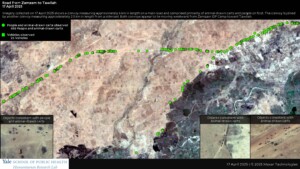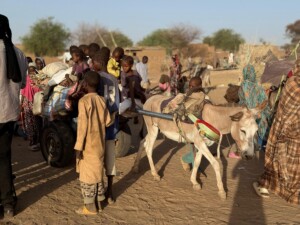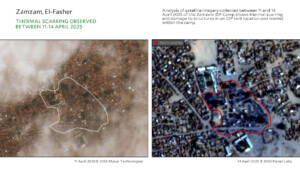Unifying Sudan’s resistance committee charters: similarities and challenges
The International Institute for Democracy and Electoral Assistance (IDEA) has analysed the draft charters of the Sudanese resistance committees to identify where they stand and where they may go, amidst attempts to unify different charters. They highlighted many similarities between both charters, but also a few caveats and concerns.
 One of the many demonstrations in Khartoum against the dictator Omar Al Bashir, a few days before he was deposed by a military coup on April 11, 2019, in which the resistance committees played an important role (Sudanese Translators for Change on Twitter)
One of the many demonstrations in Khartoum against the dictator Omar Al Bashir, a few days before he was deposed by a military coup on April 11, 2019, in which the resistance committees played an important role (Sudanese Translators for Change on Twitter)
The International Institute for Democracy and Electoral Assistance (IDEA) has analysed the draft charters of the Sudanese resistance committees to identify where they stand and where they may go, amidst attempts to unify different charters. They highlighted many similarities between both charters, but also a few caveats and concerns.
Sudan’s resistance committees emerged as a new local political agent during the December Revolution and played a huge role in mobilising the public and ousting the dictatorship. They also played an important role in opposing the military junta that took power after.
On December 19, 2018, people took to the streets of Sudan in a mass protest movement that became known as the December Revolution which led to the ousting of dictator Omar Al Bashir, who had been in power for 30 years, when the military took power in a coup in 2019.
What followed was a months-long struggle for control between the protesters and the military until a power-sharing agreement was reached in August 2019 in the form of a Constitutional Declaration, which outlined a 36-month transitional period.
During that transitional period, a Transitional Sovereignty Council (TSC) was to govern Sudan split equally between military and civilian members, who came from the Forces for Freedom and Change (‘FFC’) coalition. A civilian prime minister, PM Abdallah Hamdok, headed the government.
The army, nevertheless, remained in control of the council and thus the government for the first half of the transitional period. Commander of the Sudan Armed Forces (SAF) Lt Gen Abdelfattah El Burhan was to chair the TSC for the first 18 months before handing over power to a civilian chair from the FFC.

Right before the power handover was supposed to take place, however, Al Burhan’s military took power in a military coup on October 25, 2021, arresting PM Hamdok and several other civilian leaders and suspending the 2019 Constitutional Declaration.
The military stated that it was taking over control of the government as a necessary “correction” but hugely overestimated their support and millions took to the street to protest the 2021 coup and demand a civilian-led democratic government. Again, the local resistance committees played a key role in organising these mass protests.
Following the coup, Sudan has been in political crisis and different groups are pulling in different directions to determine the course of Sudan’s political future. The mainstream Forces for Freedom and Change-Central Council (the coalition split earlier this year) has proposed their vision for Sudan’s political transition and so have various other groups, including supporters of the coup.
Political vision
The resistance committees of Wad Madani, the capital of El Gezira, and Khartoum each published their own charter with their vision for a democratic civilian-led Sudan early in the year.
The resistance committees in Wad Madani launched the Revolutionary Charter for People’s Power (RCPP) in mid-January whilst the Khartoum resistance committees proposed the Charter for the Establishment of the People’s Authority (CEPA) in late February and signed it mid-May.
Both charters call for civilian-led democratic governance and prioritise social justice. However, they slightly differ in the tools they propose to implement these values.
The Sudanese resistance committees have been working on unifying both charters since June, to create a common stance. Originally, the deadline for the merging of the two charters was set to be July 5, but there were some disagreements.
The analysis
The IDEA analysis, which can be read in full here, hopes to raise awareness of some of the drafts’ merits “and challenges that are likely to arise”.
Researchers Hamid Khalafallah and Brooke Davies evaluate a) what the existing differences are that must be reconciled if the resistance committees are to present a united vision in negotiations with Sudan’s military component, and b) what structural features of the drafts may pose a challenge to the transitional period should they be implemented in practice.
The researchers make it clear that they do not ‘take a position’ on the drafts or make specific recommendations on how the drafts should be changed.

Similarities and differences
The charters shared a lot of similar goals, including the creation of a new political system “that promotes the rule of law and disassembles the system of elite control” and to “combat state corruption and dismantle empowerment” (tamkin*).
The resistance committees, which organise in a decentralised and hyper-localised way also share the aim to “strengthen local governments to promote the link between citizens and local government and to empower them to act on a greater set of responsibilities, such as land distribution”.
They also both propose to establish a permanent constitution and a legal framework for transitional justice, to reform and restructure the judicial authority, and to establish legal protections for unions and civil society.
They also wish to reach a comprehensive peace agreement, unify the national army, hold the security apparatus accountable and restructure the security state.
Both parties also wish to create a national economic plan that promotes equitable economic development and to take action to protect the environment, amongst many more shared proposals.
According to the researchers, the resistance committees are proposing a ‘fairly identical’ transitional system of government and process for reaching a comprehensive peace agreement with armed groups, although the proposed systems of governance were seen as too broad with large gaps as to the exact proposed structure, powers, and relationship of and between the transitional governing bodies, and differences on particular details of the peace agreement remain in place as well.
Broadness and vagueness were amongst the biggest sources of critique brought forward by the researchers, also in terms of the objectives for a transitional government.
“While the draft Charters largely agree on the broad objectives of the transitional government, with a few notable differences, those objectives remain so sweeping and broad as to likely be too vague to be implementable on their own, and/or too ambitious to be completed during a transitional period,” they explained.
‘While the draft Charters largely agree on the broad objectives (…), those objectives remain so sweeping and broad as to likely be too vague to be implementable on their own’ – Hamid Khalafallah and Brooke Davies
There were also concerns about the lack of clear mechanisms proposed to avoid creating “spoilers out of excluded political coalitions and armed groups”, who might derail the course of democratic transition, despite the fact that the charters agree to a certain extent on who should be allowed to participate in governance.
Problems also exist around the accountability of Legislative Council members in the current charters. “Neither charter gives any powers to the government to dismiss or hold TLC members to account, or to at least exercise some form of oversight. As a result, TLC members will be given permanent positions with no termination date, and no method for dismissal should they engage in illegal or unethical conduct.”
Similarly, the charters do not propose a solution to avoid or overcome gridlock over the formation and selection of government bodies, such as what happened with the Transitional Legislative Council before the October 25 coup.
“The TLC during the transitional period before the 25 October coup was never formed, in part due to an inability of the FFC to agree on a list of TLC members. Each draft now proposes the selection of TLC members by an even broader coalition of actors, and it is unclear how they will not run into the same problem as before,” the researchers write.
‘It is unclear how they will not run into the same problem as before’ – Khalafallah and Davies
They warn that “gridlock over the selection of the TLC would impede the establishment of the government, in turn likely leading to the breakdown of the entire process”.
Furthermore, the draft Charters seem to agree broadly on the order of the transitional process, but they differ on its length. “Any discussion on the transition’s length and termination must be linked to the breadth of the transition’s objectives and the capacity of the transitional government to meet them,” the researchers wrote.

The challenge of uniting the resistance committees
As explained earlier, the resistance committees emerged during the 2018 December Revolution and played an incredibly important part in Sudan’s pro-democracy movement ever since.
“The role they played in toppling [Al Bashir’s] regime ironically places a responsibility on their shoulders ‘to protect’ the revolution,” prominent Sudanese political scientist Atta El Battahani wrote for the Chr. Michelsen Institute (CMI).
Following the June 3 Massacre at the sit-in at the Army Command in Khartoum in 2019, the resistance committees ‘emerged as watch dogs’ making sure that other opposition organisations, such as the Sudanese Professional’s Association (SPA), the FFC, and political parties, would not compromise on the ideals of the December revolution in exchange for government power, El Battahani explains.
The resistance committees are decentralised and hyper-localised in their ways of operating and are mainly made up of urban youth, but crossing many geographical and social boundaries of class and ethnicity.
The youth’s disillusionment with the ‘old political club’ began a long time ago and predates the 2019 protests. Nevertheless, the resistance committees represent a new way of political thinking and organising in Sudan.
They are advocating a discourse transcending old tribal, ethnic, and regional affiliations and their horizontal organisational structure reflects their desire to maintain their autonomy and independence from political affiliations, El Battahani writes.
The committees are also “the only force trusted by families of the martyrs and the general public” because they do not represent any of the old powers or corrupt movements.
[The resistance committees] have the potential and capacity to turn the youth movement into something bigger’ – Atta El Battahani
“They have the potential and capacity to turn the youth movement into something bigger; to lift it from its narrow local platform to a national wide platform to support democratic transition,” El Battahani writes, but they will need to unify their voices and avoid disagreements to do so.
This is a dilemma for the movements as their decentralised way of organising also forms one of their strengths. Earlier this week, the resistance committees in greater Khartoum agreed on more tight collaboration, but committees some criticised the step.
The resistance committees face another obstacle, that of co-optation. Their “actual and potential power is targeted by main competing political forces,” El Battahani explains.
The military and existing political parties, from left, centre, and right, “are all trying to work their way into the [resistance committees], eventually co-opting them”.
Yet, they are fighting back, loyally continuing their ‘watch dog’ role. They have frequently declared their independence from the ‘politicking of the FFC’ and other influential opposition groups and have often criticised their ways of working and their willingness to talk or share power with the military.
‘FFC leaders have been subjected to the unforgiving scrutiny of the committees and their revolutionary ideals’ – El Battahani
“FFC leaders have been subjected to the unforgiving scrutiny of the committees and their revolutionary ideals,” El Battahani writes.
Forming a strong unified front, the resistance committees could continue to put pressure on authority and opposition alike to fulfill their democratic promises and demands and follow the course set by the December Revolution.
* Empowerment (tamkin) is the term with which the ousted government of Omar Al Bashir supported its affiliates by granting them far-going privileges, including government functions, setting up of various companies, and tax exemptions.











 and then
and then